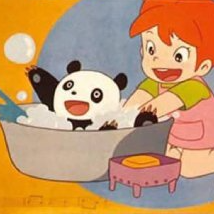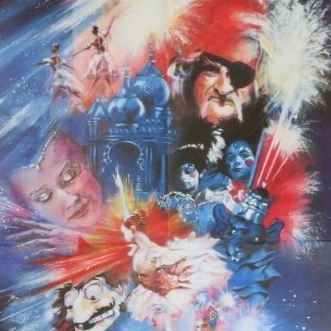Barbara
She's coming to get you.

Japanese poster | Aeon Entertainment
2019 — Japan / Germany / UK
A presentation of THEFOOL, THIRD WINDOW FILMS, RAPID EYE MOVIES, DIVERSITY MEDIA and TEZUKA PRODUCTIONS
Cast: GORO INAGAKI and FUMI NIKAIDO, with KIYOHIKO SHIBUKAWA, SHIZUKA ISHIBASHI, MINAMI, MOEMI KATAYAMA, ISSAY, RYOSUKE OHTANI and ERI WATANABE
Director and Editor: MACOTO TEZKA
Producers: SHUNSUKE KOGA with SHINYA HIMEDA and ADAM TOREL
Screenplay: HISAKO KUROSAWA
Original work: OSAMU TEZUKA
Cinematography: CHRISTOPHER DOYLE with TSOI KUBBIE
Art direction: TOSHIHIRO ISOMI with EMIKO TSUYUKI
Costumes: ISAO TSUGE
Music: ICHIKO HASHIMOTO
© Barbara Film Committee
Yosuke Mikura (Goro Inagaki) is the hottest of hotshot authors. Well, sort of. He’s not, like, winning prizes, but his stuff sells by the bucketload. It’s basically smut; the predominant assessment is that his stuff is titillating and entirely forgettable. Still, he’s much in demand by publishers and the haute monde for his sway with the public and also his money. He has a smug disdain for the lot of them… and also his peers in the industry… and also his fanbase, natch. He is willing to abuse his status to get his leg over though. Suffice to say, he’s at once in a comfortable rut, but also has pretensions of being a better artist. In the subway around Shinjuku station, he encounters Barbara (Fumi Nikaido), a down-and-out woman who is beautiful, dipsomaniacal and highly literate. He drags her drunken self back to his place with the promise of booze, apparently intent on having his way with her. This doesn’t pan out; upon reading his racy prose she bursts out laughing because, amongst other things, it’s shiiiiiiiit. He promptly throws her out and sex was had by none. Life carries on, he’s adored by hangers-on, and his apparent main squeeze, Shigeko (Minami), is the daughter of a prominent politician (Ryosuke Ohtani), who’s willing to push his name in literary circles if he writes a sterling endorsement for the upcoming Diet campaign launch (to, I guess, shore up that bored Office Lady vote). Despite this, he’s haunted by Barbara. She comes to consume his thoughts. Strange things are afoot however. While he ventures into the underworld to track down his hobo princess, the obstacles to his art seem to be removed mysteriously and with extreme prejudice.
Osamu Tezuka, as I seemingly mentioned in the Legend of the Stardust Brothers post even though it was pretty tangential, is popularly deemed the ‘father of manga’. Such an epithet is perhaps somewhat misleading as, suffice to say, the Japanese had comics prior to his post-war ascendancy, but he was highly influential in the development of the medium, as well as that of anime. The original run of the Barbara manga ran from July 1973 to May 1974 in Big Comic (1968 – present), a semi-monthly anthology aimed at adult men which seemingly saw the bulk of his less child friendly works; to that end, a risqué psychological thriller/urban fantasy about sex and art which is ostensibly inspired by The Tales of Hoffmann. Despite almost certainly being best remembered as the creator of Astro Boy and Kimba the White Lion (né Jungle Emperor Leo), it’s worth noting that his output ran the gamut in terms of style, theme, target audience, etc., and in the late ‘60s, early ‘70s, the changing climate in Japan meant he was producing a lot more aimed at older audiences… mostly in manga form, although he did try and push animated films for adult audiences; the (in)famous ‘Animerama’ films being a particularly notable early attempt at tapping that market.†
Well, anyway, as also mentioned in the Legend of the Stardust Brothers post, Macoto Tezka is his son. This here film of Barbara I have seen labelled as his first pass at adapting one of his father’s works but that isn’t actually true. It’s his first attempt at doing one in live action, having directed a few earlier animated versions, the best known of which is the TV series of Black Jack and some specials and a film related thereto between 2003 and 2006, though he also directed a short based on Akuemon (1973) in 1993. I’m not going to lie to you, his comments on the differences between adapting comics for animation and for live-action don’t entirely suggest that a good understanding of the former medium as he characterises it as essentially taking the panels and making them move. I haven’t seen any of the aforementioned stuff, maybe he’s just simplifying for effect; the actual meat of the comment that trying to translate comics to live-action directly tends to result in an off feeling are fairly on the mark.
I suppose I should also mention that I haven’t read the original comics. Physical copies of the English translation are long out-of-print and I’m apparently too cheap to pay £13 for a digital copy, ‘cause that’s a real book price, dagnabbit. From what I’m able to glean, the film is a bit loose on the details though actual story is more or less the same. The comic apparently has a greater focus on Yosuke’s sexual dysfunction; the Tezuka In English site’s page on the manga summarises it thusly: “behind the bright lights of his fame and fortune, Mikura desperately struggles to hide a dark secret – the fact that he suffers from crippling sexual perversions which are driving him towards madness”. This element would seem to be given about equal focus to the stuff about art. The film pretty much drops this, instead focussing entirely on the artistic struggle side of the equation. His weird sexual encounters, as the film presents them, have a greater emphasis on what these demon lovers represent and his encroaching madness an angst over questions regarding the worthiness (or lack thereof) of his art. Whether or not these demons, Barbara herself included, exist is another question entirely. It’s perhaps conspicuous how few people actually see her; while loitering around Yosuke’s flat, she conveniently steps out around the time anyone stops by. Other than him, the only person to register her existence, aside from her equally mysterious mother (Mnemosyne (Eri Watanabe), geddit?) and her clique, is an apparently spurned lover (Issay) who can no longer art good now that she’s gone.
So, in case you didn’t get that, the implication is that Barbara is a muse in the most literal sense. Drivin’ the men folk nuts for arts. It’s always men with this demented art lust. It’s that Ancient Greek thing where women are essentially monsters which exist pretty much to have children and/or destroy men. Mind you, go pretty much anywhere on the internet and you can find people espousing the same kind of shit, so…
Anyway, back to Barbara… I wouldn’t sympathise for Yosuke with his descent into madness too much. He’s a misogynistic prick and frankly his fall only makes him less so, to a point at any rate, by virtue of having Barbara there to call him out on his shit. Or maybe he just trades in one sort of misogyny for another. In lieu of disposability, her role of muse makes her something he must possess, but more than that, he has to consume her into his self. Of course, however, in doing so, he will inevitably lose her. What of the art life then? By her very nature, then, surely she cannot be subsumed into him. This burning jealous desire for her, what she represents, is destined to lead to disaster. …Assuming she isn’t just some random weirdo and the Byronic dickhead hasn’t simply succumbed to his encroaching madness on his own. Hamartia’s a bitch, etc.
The film is structured in a fairly obvious three act manner. While the slope towards the fantastic is pretty consistent throughout, the plot itself has some pretty clear divides, eventually culminating in the last act being almost entirely a two hander between the two leads as everyone who stands in Yosuke’s way is removed. While this mostly makes sense in context, there is a problem however in that the big crisis that propels this phase of the action forward; Mnemosyne sending her occultist hangers-on to retrieve Barbara, likely violently; is pretty much ignored after it’s introduced (for what it’s worth, there is a little more to that thread in the deleted scenes, but it still doesn’t really resolve). Of course though, perhaps the grand lack of evidence of the cult pursuing the pair could be taken as further evidence as to Yosuke’s delusional state. How much of the film is ‘real’? It could go either way.
† The
Animerama films are generally deemed to be
A Thousand and One Nights (1969),
Cleopatra (1970), and
Belladonna of Sadness (1973). In actuality,
Belladonna was originally marketed under the banner ‘Animeromanesque’, but it was made by Tezuka’s erstwhile studio, Mushi Production, with much of the same crew, apart from Tezuka himself who’d already left the sinking ship by then; the failure of
Cleopatra, seemingly a passion project of his, at the box office had put a lot of strain on the already ailing studio (apparently management had been skimming). While it very much failed to turn the studio’s fortunes around,
Belladonna is, ironically, the one that’s probably best remembered and most influential.
At time of writing, Barbara is available to rent off of Amazon and Apple TV. I recommend JustWatch for keeping up with where films are streaming (including this one!). Alternatively, physical copies are reportedly available for rent via Cinema Paradiso.
The film presently has an 18 rating (last being submitted in 2021), with the BBFC citing "necrophilia, [and] strong sex"
Sources
Patten, F., 2014. 'Tezuka's "Adult" Features: "A Thousand and One Nights" (1969)', Cartoon Research. [online]. Available at: <https://cartoonresearch.com/index.php/tezukas-adult-features-a-thousand-and-one-nights-1969/> [Accessed 7 September 2021].
Patten, F., 2014. 'Tezuka's Adult Features: "Cleopatra" (1970)', Cartoon Research. [online]. Available at: <https://cartoonresearch.com/index.php/tezukas-adult-features-cleopatra-1970/> [Accessed 7 September 2021].
Patten, F., 2014. 'The Last Days Of Mushi Pro', Cartoon Research. [online]. Available at: <https://cartoonresearch.com/index.php/the-last-days-of-mushi-pro/> [Accessed 7 September 2021].
Tezuka in English, 2017?. Barbara (Manga). [online]. Available at: <http://tezukainenglish.com/wp/?page_id=172> [Accessed 7 September 2021].
Tezuka Osamu Official, 2009?. ばるぼら. [online] Available at: <https://tezukaosamu.net/jp/manga/364.html> [Accessed 27 August 2021].
Toole, M., 2014. 'The Mike Toole Show – Cult Classics', Anime News Network. [online]. Available at: <https://www.animenewsnetwork.com/the-mike-toole-show/2014-11-02/.80579> [Accessed 7 September 2021].



